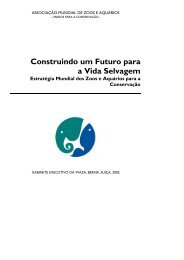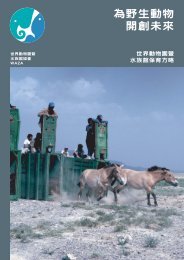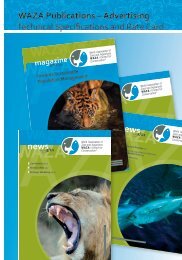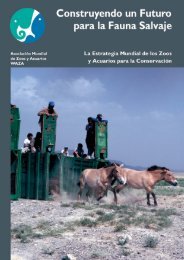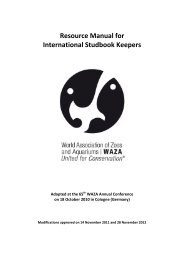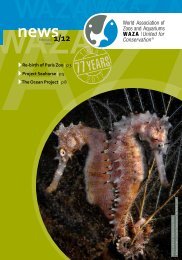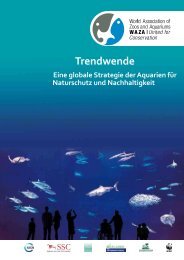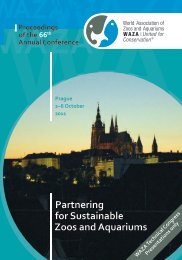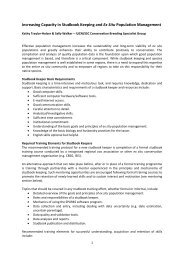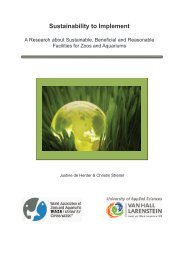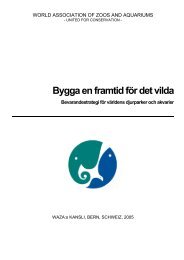Towards Sustainable Population Management - Waza
Towards Sustainable Population Management - Waza
Towards Sustainable Population Management - Waza
Create successful ePaper yourself
Turn your PDF publications into a flip-book with our unique Google optimized e-Paper software.
WAZA magazine Vol 12/2011<br />
Dennis W. H. Müller 1 *, Laurie Bingaman Lackey 2 ,<br />
W. Jürgen Streich 3 , Jörns Fickel 3 , Jean-Michel Hatt 1 & Marcus Clauss 1<br />
How to Measure Husbandry<br />
Success? The Life Expectancy<br />
of Zoo Ruminants<br />
Summary<br />
Relative life expectancy (i.e. the<br />
average life expectancy of a species<br />
expressed as a percentage of the<br />
maximum longevity ever reported for<br />
this species) may describe husbandry<br />
success in captive populations. By<br />
correlating the relative life expectancy<br />
with biological characteristics and<br />
husbandry factors for different species,<br />
reasons for variations in relative<br />
life expectancy can be detected. We<br />
analysed data for 166,901 ruminants<br />
of 78 species and demonstrated<br />
the presence of such a correlation<br />
between relative life expectancy and<br />
percentage grass in the species’ natural<br />
diet (not necessarily the diet fed<br />
in zoos). This suggests that species<br />
adapted to grass (so-called grazers,<br />
such as bison and wildebeest) can be<br />
managed more easily when compared<br />
to species that feed on leaves<br />
and twigs (so-called browsers, such<br />
as giraffe and moose). Another finding<br />
of our analysis is a true success<br />
story of zoo animal management: the<br />
1 Clinic for Zoo Animals, Exotic Pets<br />
and Wildlife, Vetsuisse Faculty,<br />
University of Zurich, Zurich,<br />
Switzerland<br />
2 International Species Information<br />
System, Eagan, MN, USA<br />
3 Leibniz Institute for Zoo and Wildlife<br />
Research, Berlin, Germany<br />
* E-mail for correspondence:<br />
dmueller@vetclinics.uzh.ch<br />
relative life expectancy was higher in<br />
species that were managed by an international<br />
studbook than in species<br />
not managed this way. This highlights<br />
the positive effect of intensive<br />
studbook management on the overall<br />
husbandry success of the respective<br />
species. Translating these results into<br />
husbandry recommendations, our<br />
approach can help to improve zoo<br />
animal husbandry.<br />
Background<br />
Zoo animal husbandry is aimed at<br />
constantly improving husbandry conditions,<br />
provision of veterinary care,<br />
reproductive success and thus ultimately<br />
husbandry success. Important<br />
questions arise from these aims: how<br />
can husbandry success be measured<br />
objectively, and how can we improve<br />
it on the basis of scientific results?<br />
Although some zoological institutions<br />
make a great effort to study various<br />
aspects of wellbeing for certain species,<br />
comparative analyses needed<br />
to determine factors influencing the<br />
husbandry success of different species<br />
in captivity are rare (Mason 2010).<br />
In 2003, WAZA proclaimed the goal<br />
“to exercise the highest standards of<br />
animal welfare”, leading to the question<br />
of how husbandry success and<br />
animal welfare can be measured objectively.<br />
A comparison of life history<br />
parameters such as breeding success<br />
per year or life expectancy between<br />
a zoo population and a wild population<br />
is an option to find out whether<br />
a species fares better in captivity<br />
than in the wild. In comparing three<br />
populations of wild but unhunted<br />
deer species with their respective zoo<br />
populations, we demonstrated that<br />
life expectancies of red deer (Cervus<br />
elaphus) and reindeer (Rangifer<br />
tarandus) were within the same range<br />
or even markedly higher in zoos,<br />
whereas captive roe deer (Capreolus<br />
capreolus) had a shorter life expectancy<br />
than their free-ranging conspecifics<br />
(Müller et al. 2010a).<br />
We believe that the problems in<br />
providing adequate browse to captive<br />
roe deer (a typical browser that feeds<br />
on leaves and twigs) and problems<br />
associated with more crowded<br />
conditions in zoos (as roe deer live<br />
predominantly solitarily in the wild)<br />
may have led to nutritional deficiencies<br />
and increased stress, leading to<br />
shorter life expectancy in captivity.<br />
On the other hand, reindeer and red<br />
deer are naturally socially living and<br />
are both so-called mixed feeders,<br />
adapted to feed moderate amounts<br />
of grass. Thus, they cope well in zoos<br />
and achieve comparatively high life<br />
expectancies. Unfortunately, such<br />
analyses will be restricted to a few<br />
exemplary comparisons, as reliable<br />
data for free-ranging populations are<br />
missing for most species. To test our<br />
hypotheses that the social system<br />
and feeding behaviour of a species<br />
in the wild have an influence on<br />
husbandry success, we conducted an<br />
analysis of the life expectancy of ruminant<br />
species (deer, giraffes, cattle,<br />
antelopes, gazelles, etc.) in zoos.<br />
37<br />
»



